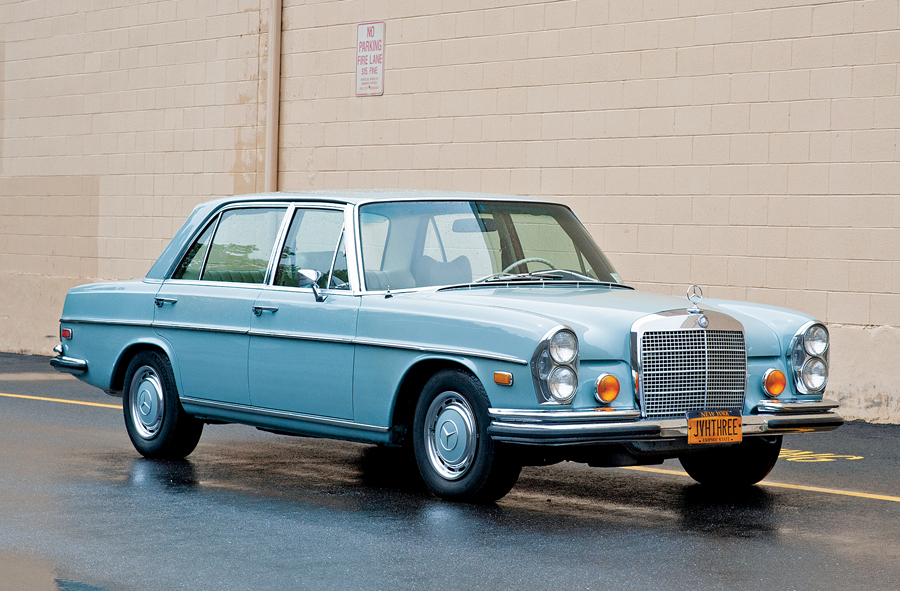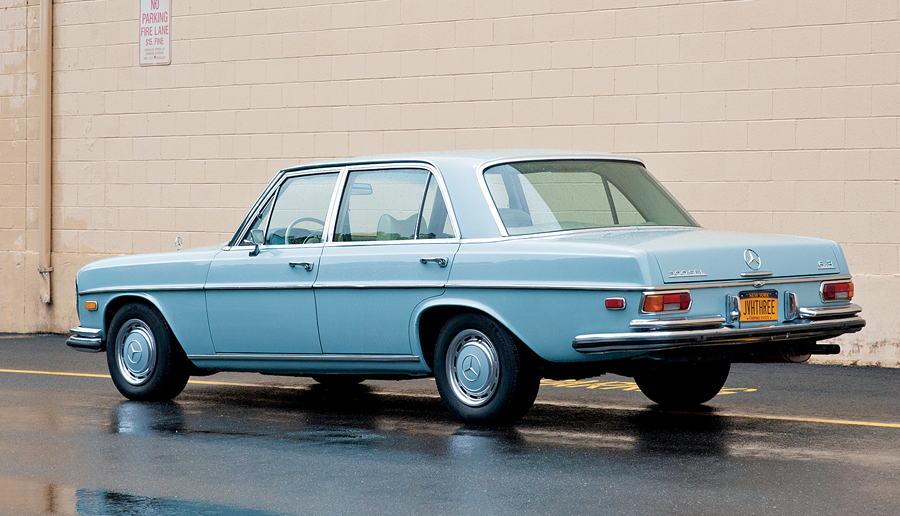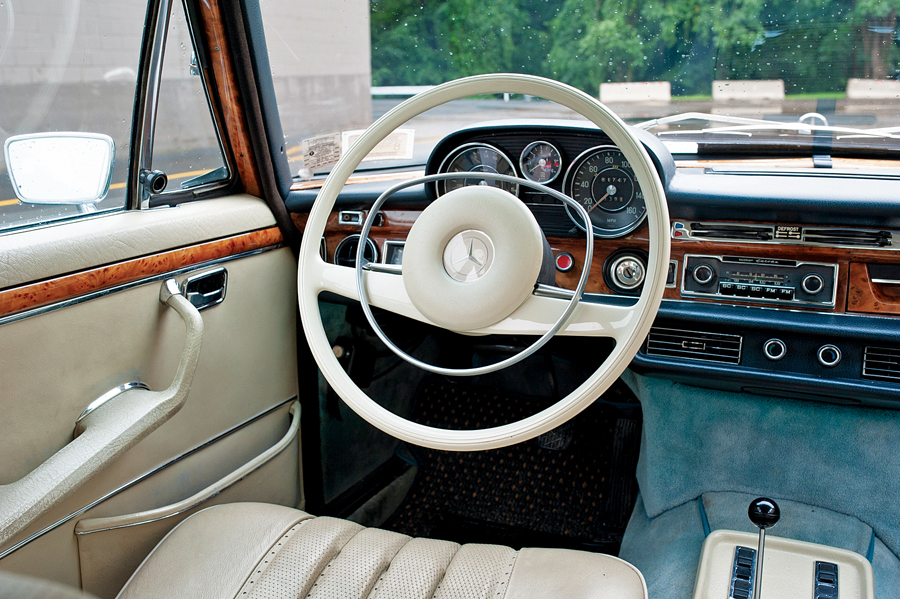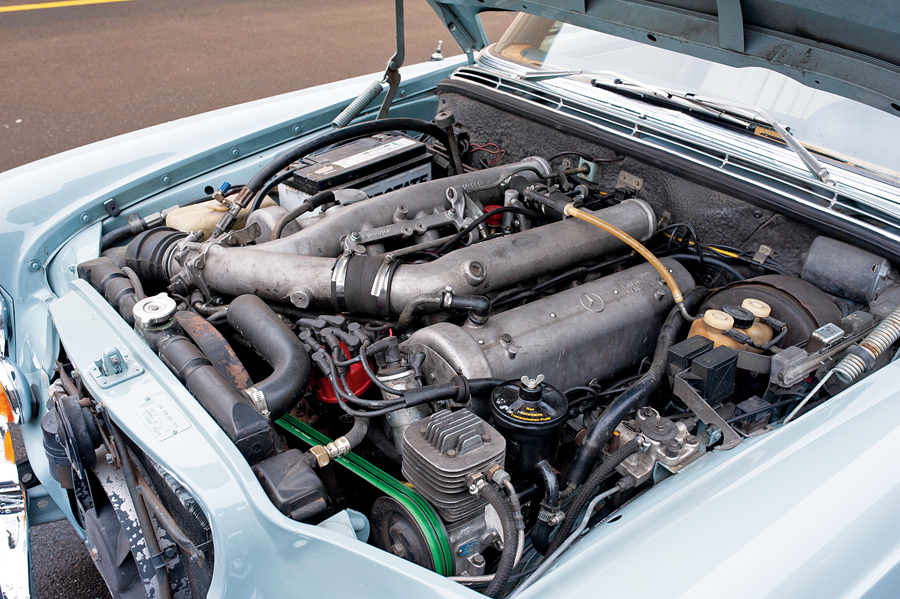SCM Analysis
Detailing
| Vehicle: | 1970 Mercedes-Benz 300SEL 6.3 |
| Years Produced: | 1968–72 |
| Number Produced: | 6,526 |
| Original List Price: | $14,530 (1969) |
| SCM Valuation: | $49,500 |
| Tune Up Cost: | $1,450 (includes ignition points and condenser, fuel filter, oil service, valve adjustment and air filter) |
| Distributor Caps: | $18 |
| Engine Number Location: | On engine block behind left cylinder head |
| Club Info: | International M-100 group |
| Website: | http://www.m-100.cc |
| Alternatives: | 1966–69 Maserati Quattroporte, 1972–73 Jaguar XJ12, 1975–80 Mercedes-Benz 450SEL 6.9 |
| Investment Grade: | B |
This 1970 Mercedes-Benz 300SEL 6.3, Lot 142, sold for $60,480, including buyer’s premium, at Bonhams’ Simeone Foundation Automotive Museum sale in Philadelphia, PA, on October 8, 2018.
A full sorting of a 300SEL 6.3 (Mercedes chassis code 109.018) is a frequently served menu item at Pierre Hedary’s.
Often there are several of these beasts under our care — usually with a considerable list of needs attached. That doesn’t mean that the 300SEL 6.3 is fragile — many soldier on despite decades of neglect. Still, the mighty M100 V8 flogs the driveline like an industrial jackhammer, and the air suspension systems have an interval where they require service to ensure unquestionable reliability.
Unfortunately, while the auction catalog states that invoices abound for major repairs on this 6.3, there are some critical details missing, which I’m going to point out.
Functional? Sure! Fully sorted? Unlikely
The auction summary notes that the engine was overhauled and that significant documentation of this W109’s mechanical work is provided. I frequently have to evaluate W109s for clients, and the first question I ask is, “Does the car’s mechanical appearance and function reflect the claim of extensive service?”
I urge you to look at the photos. If you’re familiar with the W109, you will likely agree with me that the surface details of the engine and its components are sloppy.
Thus, while this 6.3 is functional, I will argue that there’s still plenty of sorting left to do.
If this is really an 83,000-mile example, it should not have needed an “overhaul” unless it was run out of oil, seriously overheated or parked for decades with excessive moisture in the cylinders.
Timing-chain failure on these engines is uncommon, and even with worn valves and leaky guides, they continue to run decently.
An oil leak from the back of a cylinder head will occasionally torment the owner of a poorly maintained car, but the M100 engine is nearly indomitable.
Cut corners are painfully apparent
The exact reason why this engine was rebuilt is not mentioned. What I see, however, are a number of obvious shortcuts that should have been resolved during this extensive “overhaul.”
Here are some photographically supported examples:
The vacuum supply hose to the brake booster has been patched back together. Such patchwork is unacceptable, as this problem could have been rectified with a phone call to the Mercedes-Benz Classic Center.
How about the aging and poorly fabricated a/c hoses? This 6.3 also features mismatched engine hardware, air-suspension compressor belts from the local parts store, and clunky, generic American hose clamps.
One would hope that if a qualified Mercedes specialist performed the repairs, they wouldn’t have neglected so many details. You can’t entrust your 6.3 to Goober Pyle and expect him to “get it right.”
These items might sound insignificant to you, but Mercedes-Benz aficionados scrutinize these specific details. The signs of a well-preserved example versus a W109 that has been haphazardly serviced are painfully obvious under knowledgeable examination.
The judges at Misselwood probably never lifted the hood.
Someone get me a spray bottle!
Concerning the W109, the entire suspension and driveline are among the most-neglected systems. In this case, no real information is provided about how long the air suspension stays up, how old the bellows are and whether the four air-suspension valves have been rebuilt.
Case in point, the main air-suspension valve, visible in the driver’s side engine-compartment photo, appears untouched. While extensive repairs to the air-suspension system are noted, that doesn’t mean that it has been refurbished the right way.
For safety purposes, the airbags should be replaced every 15 years, and they are readily available from Mercedes. The air suspension should maintain its height ad infinitum. Otherwise, a leveling valve is leaking down.
For immediate air-suspension diagnosis, spray the valves and fittings with soapy water, so bubbles will show any major air leaks.
The front subframe mounts on these cars are frequently rotted, subsequently detaching the subframe at its most critical mounting point. If that doesn’t scare you, consider the fact that the subframe supports the engine, transmission, front suspension and brakes.
If mounts begin to fail, you should remove the whole subframe and repair anything associated with it that needs to be addressed.
No photos of the underside or rear axle are present, creating another gray area. The rear axle on the 6.3 was beefed up with an improved spider gear housing, but the rear axle bearings and axle boot are the same as any other W109. These components and any rubber parts should be scrutinized at this age, especially on a 6.3.
Rare, sexy Parchment leather interior
Despite my disdain for this car’s mechanicals, the original finishes cement its place in the market.
While most 6.3 buyers are looking for examples in black or silver, lighter colors give this car a unique presence. It is equipped with a desirable sunroof and retains what appears to be an original, gorgeous Parchment leather interior.
All of these details make this car worth the $60,000 — even if more mechanical needs remain to be discovered. The recent repair bills likely had a minimal impact on the sales price, meaning that bidders understood improvements were needed.
The still-developing 6.3 market
I am frequently asked about the values of low-compression 1970 and later-model-year 6.3s compared to the high-compression examples sold in the United States until the summer of 1969. Examples from 1968 and 1969 do not command a significant premium right now, but this could change in the future.
High-compression cars have always appealed to W109 anoraks. Eventually, this could translate to a tangible market effect.
If you’re considering the purchase of a 300SEL 6.3, you should also consider the 300SEL 3.5 and 4.5, which are much easier W109s to live with. The 6-cylinder 300SEL (I own one) is also a great car, but there are nights when I miss my old 6.3.
Prices of these cars are working their way upward, and solid examples are no longer available for used S Class money. This example was just barely well bought. However, the new owner may have to spend another $25,000 to purge it of any remaining demons.
Yes, spending that money is well worth it. ♦
(Introductory description courtesy of Bonhams.)



